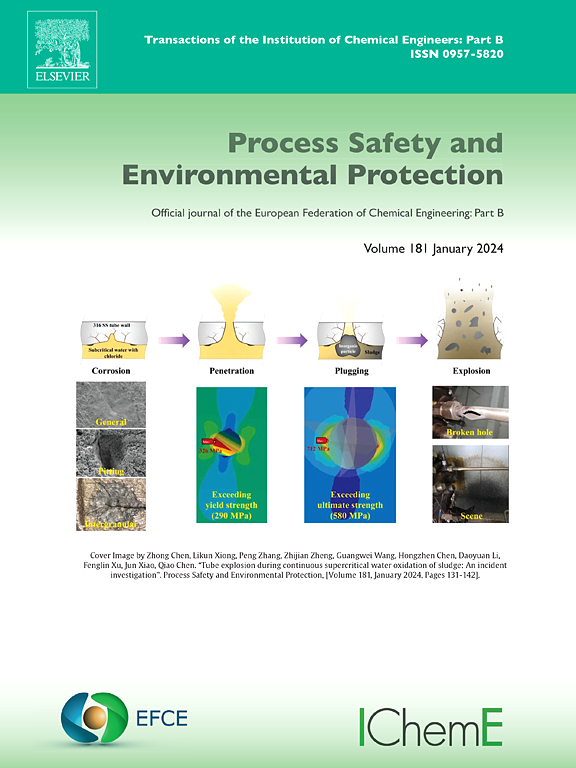Green preparation, microstructure and human health risk assessment of phosphorus tailings-based unfired artificial lightweight aggregates
IF 7.8
2区 环境科学与生态学
Q1 ENGINEERING, CHEMICAL
引用次数: 0
Abstract
Aiming at the safety hazards brought about by the accumulation of industrial solid waste (SW) in Lianyungang City, Jiangsu Province, as well as the resource shortage and high energy consumption problems faced by the manufacture of traditional building materials. This work is based on the concept of "full solid waste utilization" and uses industrial SW materials such as phosphorus tailings (PT) and alkali slag (SR) to prepare non-fired artificial lightweight aggregates. The study systematically explored the impact of various kinds of mixed water and curing conditions on the physical characteristics, microstructure, and durability of phosphorus tailings-based lightweight aggregates (PT-LWA). Additionally, the potential human health risk assessment and potential ecological risk index models were employed to assess the environmental risks and human health impacts associated with heavy metals (HMs) in PT-LWA. In addition, the carbon emissions and economic costs of PT-LWA were analyzed. The findings indicated that the PT-LWA prepared with mixed water NS 12 exhibited the best performance when the steam curing temperature was 90 °C. Its water absorption, cylinder crush strength, softening coefficient, and apparent density were found to be 13.67 %, 10.5 MPa, 0.945, and 1054.11 kg/m³, respectively. All these parameters met the requirements laid out in the Chinese standard GB/T 17431.1-2010. According to the results obtained from the human health risk assessment, hand-to-mouth intake was revealed to be the primary exposure route for the non-carcinogenic risks of various HMs in PT-LWA. The carcinogenic risks for both adults and children were low and within the tolerable range for humans.
磷尾矿免燃人工轻骨料的绿色制备、微观结构及人体健康风险评价
针对江苏省连云港市工业固体废弃物积累带来的安全隐患,以及传统建材制造面临的资源短缺、能耗高的问题。本工作以“固体废物充分利用”为理念,利用磷尾矿(PT)、碱渣(SR)等工业SW材料制备非烧制人工轻骨料。系统探讨了不同混合水和养护条件对磷尾矿轻骨料(PT-LWA)物理特性、微观结构和耐久性的影响。此外,采用潜在生态风险评价和潜在生态风险指数模型对PT-LWA重金属环境风险和人类健康影响进行了评价。此外,还分析了PT-LWA的碳排放和经济成本。结果表明,以NS - 12为混合水制备的PT-LWA在蒸汽养护温度为90 ℃时性能最佳。其吸水率为13.67 %,缸压强度为10.5 MPa,软化系数为0.945,表观密度为1054.11 kg/m³。这些参数均符合中国标准GB/T 17431.1-2010的要求。人体健康风险评估结果显示,手-口摄入是PT-LWA中各种HMs非致癌风险的主要暴露途径。成人和儿童的致癌风险都很低,在人类可接受的范围内。
本文章由计算机程序翻译,如有差异,请以英文原文为准。
求助全文
约1分钟内获得全文
求助全文
来源期刊

Process Safety and Environmental Protection
环境科学-工程:化工
CiteScore
11.40
自引率
15.40%
发文量
929
审稿时长
8.0 months
期刊介绍:
The Process Safety and Environmental Protection (PSEP) journal is a leading international publication that focuses on the publication of high-quality, original research papers in the field of engineering, specifically those related to the safety of industrial processes and environmental protection. The journal encourages submissions that present new developments in safety and environmental aspects, particularly those that show how research findings can be applied in process engineering design and practice.
PSEP is particularly interested in research that brings fresh perspectives to established engineering principles, identifies unsolved problems, or suggests directions for future research. The journal also values contributions that push the boundaries of traditional engineering and welcomes multidisciplinary papers.
PSEP's articles are abstracted and indexed by a range of databases and services, which helps to ensure that the journal's research is accessible and recognized in the academic and professional communities. These databases include ANTE, Chemical Abstracts, Chemical Hazards in Industry, Current Contents, Elsevier Engineering Information database, Pascal Francis, Web of Science, Scopus, Engineering Information Database EnCompass LIT (Elsevier), and INSPEC. This wide coverage facilitates the dissemination of the journal's content to a global audience interested in process safety and environmental engineering.
 求助内容:
求助内容: 应助结果提醒方式:
应助结果提醒方式:


